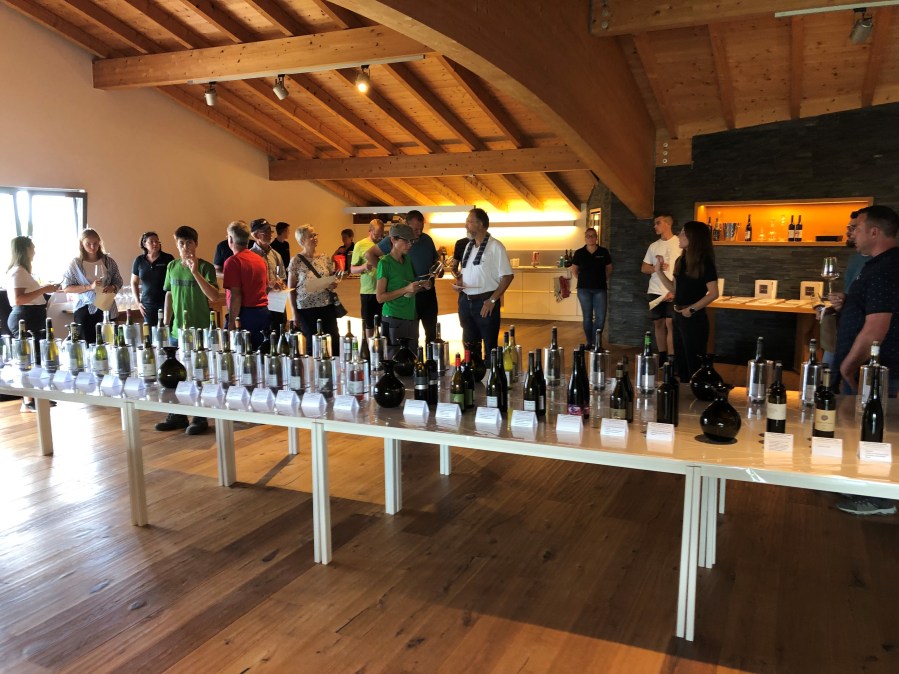In his latest musing, viticulturist Sam Doncaster says berry for berry, there are many a new variety that hold more flavour than the possibly slightly under ripe V. vinifera grapes.
There have been rounds of visits with walks and talks and tastings throughout the regions where propagation and research takes place.
Here at Freytags we had about 150 people come through to see what is new. A 50 or so bottle tasting of a range of interpretations stemming from new cool climate varieties were available to be tasted.
This also included a table hosted by Erbsloh, the giant German-based wine industry supplier of agents and bio-assistants to the wine industry, (yeasts, malolactic cultures, fining and filtration agents etc).
They recognise the importance of new varieties for the future in cool climate wine making, and run there own research into assisting a better outcome. It was from this that we got to taste wines indicating improved ‘performance for Piwi’s.’
There were also a few wines from the local regional research station, who for years now have undertaken numerous avenues of research into new varieties.
However most of the wines were good examples from local commercial release, and all of them capable of being lined up with other local wines from Vitis Vinifera.
I heard a story about some of the new variety wines from the Netherlands, creating some intrigue. Winemakers steeped in traditional wine making from V. Vinifera, sometimes stumble a bit where it can take a few years for them to re-learn how to bring out the best from new varieties. Not so the winemakers of the Netherlands where they start out from the beginning working with new varieties. The result being good wine making unhindered by thoughts of making wines the same as other places in Europe.
Same old, same old, but different, where there is a good market for capable wines, albeit in a slightly differing stylistic direction.
New thinking, younger wine makers perhaps, and an open market place; all unhindered by tradition and direct comparisons to previous efforts.
Given that UK still wine making is not so great in volume or range of styles, then perhaps there lies a possibility for people to learn from the Netherlands experience? And go out, be bold, and to make wines with a point of difference.
Certainly within a cooler climatic region, berry for berry, there are many a new variety that holds more flavour than the possibly slightly under ripe V. vinifera grapes. Good blending characteristics as well.
Meanwhile here there have been opportunities to visit trial blocks of vines, from first year’s growth seedling fields through to small blocks of previously bred vines that whilst capable, have not been adopted by growers. However they retain a position of usefulness in that they do indeed hold an interesting genetic mix, and could yet play a useful part in a breeding programme.
It is interesting to see vines that hold a few perhaps unusual individual characteristics that might be of interest to growers. For example vines that grow directly upwards, thus making wire lifting etc very easy.
Others that hold only a light canopy in the fruiting zone, thus not requiring leaf plucking, (given that they hold unusual degree’s of resistance to botrytis,) and in a year like this there lies no risk of sun burn on the grapes. Maybe the bunches are so loose that ventilation is ensured through out the cluster. Spotlessly clean and effective leaves giving improved photosynthesis until late in the season, whilst the grapes get a longer period of ‘hang time’.
Many are the differing attributes from new varieties, and I include increased yields as well as an assured earlier ripening. Cool climate table grapes as well.
From the perspective of visual impact, looking over a block of 40,000 new varieties where perhaps 95% are all blotched and marked, yellow/brown from leaf infections or grey streaked in mildew, shows clearly the individual resistant vines.
These few sturdy souls stand out like a beacon with their almost glossy, clean and green leaves amid the impending doom around them.
Breeding certainly is effective in producing resistant vines, but will the grapes they produce be noteworthy? This is the next step in assessments along the path of discovering good selections.
Having looked over blocks of vines throughout Europe, people are making their plans to give further attentions to but a few vines.
Meanwhile back in the breeding fields of Spain the berries have already been harvested, and the seeds are washed clean prior to preparation for planting out in mid winter warm houses. The cross bred bunches here in the Pfalz being just a few weeks later.
The work in viticulture never ‘lets up’, well it doesn’t if you seek to learn about improvements increasingly available to us.
However now is the time to acknowledge that most of this years growing season work is done, and it becomes time to hand over the results of your efforts to the process workers in the cellar.
I drive on to the UK tomorrow (September), leaving behind me the thoughts and plans for the new, the different, the better to be grafted up for next year’s start in the futuristic efforts of field trials. Wondering as I go: “Who wants to do this work, to be involved in successes yet to be dreamed about ?” I too am but an occasional seasonal process worker, where there lies much to be attended to.





